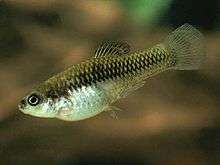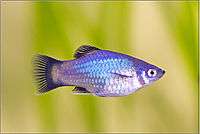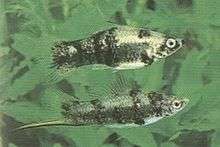Xiphophorus
| Xiphophorus | |
|---|---|
| Green swordtail, Xiphophorus hellerii | |
| Scientific classification | |
| Kingdom: | Animalia |
| Phylum: | Chordata |
| Class: | Actinopterygii |
| Order: | Cyprinodontiformes |
| Family: | Poeciliidae |
| Subfamily: | Poeciliinae |
| Genus: | Xiphophorus Heckel, 1848 |
| Type species | |
| Xiphophorus hellerii Heckel, 1848 | |
| Species | |
|
See text. | |
Xiphophorus is a genus of euryhaline and freshwater fishes in the family Poeciliidae of order Cyprinodontiformes, native to Mexico and northern Central America. The many Xiphophorus species are all called either platyfish (or platies) or swordtails. The type species is X. hellerii, the green swordtail. Platyfish and swordtails are live-bearers, meaning that they reproduce via internal fertilization. The name Xiphophorus derives from the Greek words ξίφος (dagger) and φόρος (bearer), referring to the gonopodium. All are small fishes, which reach maximum lengths of 3.5–16 cm (1.4–6.3 in) depending on the exact species.[1]
Distribution and conservation status

The various Xiphophorus species range from the southern Rio Grande basin in Mexico, through eastern drainages in the country (river basins draining into the Gulf of Mexico), to northern Guatemala, Belize and northern Honduras.[2][3]
Three species and their hybrids are common in the aquarium trade: the green swordtail (X. hellerii), the southern platyfish (X. maculatus) and the variable platyfish (X. variatus). These three are the only species that have large native ranges.[2] They have also been introduced outside their native range (both in Mexico, Central America and other continents) where they sometimes represent a serious risk to native species, including other, more localized Xiphophorus.[4]
All other species of Xiphophorus are highly localized and mostly endemic to Mexico. Only three of the localized species, the Chiapas swordtail (X. alvarezi), X. mayae and X. signum, range outside Mexico and the last two are the only Xiphophorus species not found in Mexico at all.[2][3] In many locations there are two sympatric species,[3] but the localized species are mostly (though not entirely) separated from each other, even when they are restricted to the same river basin.[2] This includes three restricted species in the Rio Grande basin (all fully separated), nine restricted species in the Pánuco River basin (mostly separated) and three restricted species in the Coatzacoalcos River basin (mostly separated).[2]
IUCN lists the marbled swordtail (X. meyeri) and the northern platyfish (X. gordoni) as Endangered, while the Monterrey platyfish (X. couchianus) is listed as Critically Endangered. In addition to those three, Mexican authorities recognize the yellow swordtail (X. clemenciae) and Catemaco platyfish (Xiphophorus milleri) as threatened.[4] Almost all the Xiphophorus, including the rare species, have captive populations that are maintained as an "insurance" at breeding centers and by dedicated private aquarists.[4][5][6]
Human uses

Xiphophorus species are regularly used in genetic studies, and scientists have developed many interspecific hybrids.[7] The Xiphophorus Genetic stock center, founded by Myron Gordon in 1939, is an important source of these fish for research.[5]
In addition, several species are commonly kept by aquarium hobbyists, especially the green swordtail (X. helleri), southern platyfish (X. maculatus), and variable platyfish (X. variatus). In fact, these are a key category in fishkeeping, a group of extremely hardy livebearing fish, along with the molly and guppy, that adapt to almost any water conditions, from warm temperate to tropical, freshwater to fully marine. Unlike some species, these are available almost completely as captive-raised, because of the ease with which they breed.
Species and taxonomy


There are currently 28 recognized species in this genus, according to FishBase.[1] Two of these species, X. clemenciae and X. monticolus, are likely the result of natural hybrid speciation (ancestors of both are a platy species and a swordtail species).[2][3] Two other proposed species, X. kosszanderi and X. roseni, are recognized by FishBase,[1] but not by all other authorities, as the first appears to be a hybrid between X. variatus and X. xiphidium, and the second between X. variatus and X. couchianus (X. kosszanderi and X. roseni have not undergone speciation as in X. clemenciae and X. monticolus).[2][8] Otherwise hybridization in the wild is uncommon in this genus and only known from three or four locations, despite the fact that many sites have two sympatric species.[9]
Although traditionally divided into swordtails and platies, this separation is not supported by phylogenetic studies, which have shown that the swordtails are paraphyletic compared the platies. They can, however, be divided into three monophyletic groups: the northern swordtails (of the Pánuco River basin, marked with a star* in the list), southern swordtails (southern Mexico to Honduras) and the platies.[2]
Despite their common names, the marbled swordtail (X. meyeri) is a part of the platy group based on its genetics and the short-sword platyfish (X. continens) is a part of the swordtail group based on its genetics.[2]
Swordtails (Xiphophorus)
- Xiphophorus alvarezi D. E. Rosen, 1960 (Chiapas swordtail)
- Xiphophorus birchmanni* Lechner & Radda, 1987 (sheepshead swordtail)
- Xiphophorus clemenciae Álvarez, 1959 (yellow swordtail)
- Xiphophorus continens* Rauchengerger, Kallman & Morizot, 1990 (short-sword platyfish)
- Xiphophorus cortezi* D. E. Rosen, 1960 (delicate swordtail)
- Xiphophorus hellerii Heckel, 1848 (green swordtail)
- Xiphophorus kallmani M. K. Meyer & Schartl, 2003
- Xiphophorus malinche* Rauchengerger, Kallman & Morizot, 1990 (highland swordtail)
- Xiphophorus mayae M. K. Meyer & chartl, 2002
- Xiphophorus mixei Kallman, Walter, Morizot & Kazianis, 2004 (Mixe swordtail)
- Xiphophorus montezumae* D. S. Jordan & Snyder, 1899 (Montezuma swordtail)
- Xiphophorus monticolus Kallman, Walter, Morizot & Kazianis, 2004 (southern mountain swordtail)
- Xiphophorus multilineatus* Rauchengerger, Kallman & Morizot, 1990
- Xiphophorus nezahualcoyotl* Rauchengerger, Kallman & Morizot, 1990 (mountain swordtail)
- Xiphophorus nigrensis* D. E. Rosen, 1960 (Panuco swordtail)
- Xiphophorus pygmaeus* C. L. Hubbs & Gordon, 1943 (pygmy swordtail)
- Xiphophorus signum D. E. Rosen & Kallman, 1969
Platies (Platypoecilus)
- Xiphophorus andersi M. K. Meyer & Schartl, 1980 (spiketail platyfish)
- Xiphophorus couchianus (Girard, 1859) (Monterrey platyfish)
- Xiphophorus evelynae D. E. Rosen, 1960 (Puebla platyfish)
- Xiphophorus gordoni R. R. Miller & W. L. Minckley, 1963 (northern platyfish)
- Xiphophorus kosszanderi M. K. Meyer & Wischnath, 1981 – often not recognized as a valid species,[2] as likely a hybrid[8]
- Xiphophorus maculatus (Günther, 1866) (southern platyfish)
- Xiphophorus meyeri Schartl & Schröder, 1988 (marbled swordtail)
- Xiphophorus milleri D. E. Rosen, 1960 (Catemaco platyfish)
- Xiphophorus roseni M. K. Meyer & Wischnath, 1981 – often not recognized as a valid species,[2] as likely a hybrid[8]
- Xiphophorus variatus (Meek, 1904) (variable platyfish)
- Xiphophorus xiphidium (Gordon, 1932) (swordtail platyfish)
References
- "Xiphophorus". Integrated Taxonomic Information System. Retrieved 9 December 2004.
- 1 2 3 Froese, Rainer, and Daniel Pauly, eds. (2018). Species of Xiphophorus in FishBase. September 2018 version.
- 1 2 3 4 5 6 7 8 9 10 11 Kang, J.H.; M. Schartl; R.B. Walter; A. Meyer (2013). "Comprehensive phylogenetic analysis of all species of swordtails and platies (Pisces: Genus Xiphophorus) uncovers a hybrid origin of a swordtail fish, Xiphophorus monticolus, and demonstrates that the sexually selected sword originated in the ancestral lineage of the genus, but was lost again secondarily". BMC Evolutionary Biology. 13 (25). doi:10.1186/1471-2148-13-25.
- 1 2 3 4 Meyer, A.; W. Salzburger; M. Schartl (2006). "Hybrid origin of a swordtail species (Teleostei: Xiphophorus clemenciae) driven by sexual selection". Molecular Ecology. 15: 721–730. doi:10.1111/j.1365-294X.2006.02810.x.
- 1 2 3 Ceballos, G.; E.D. Pardo; L.M Estévez; H.E. Pérez, eds. (2016). Los peces dulceacuícolas de México en peligro de extinción. pp. 48, 279–284. ISBN 978-607-16-4087-1.
- 1 2 "Xiphophorus Genetic Stock Center". Texas State University. Retrieved 23 September 2018.
- ↑ Coletti, T. (December 2007). "Preserving Xiphophorus couchianus in the Home Aquarium, Part I: Sad History & Unanswered Questions". tfhmagazine.com. Retrieved 23 September 2018.
- ↑ "Archived copy". Archived from the original on October 23, 2014. Retrieved October 22, 2014.
- 1 2 3 Meyer M (1983). "Xiphophorus-Hybriden aus Nord-Mexiko, mit einer Revision der Taxa X. kosszanderi und IIIX. roseni". Zoologische Abhendlungen Steatliche Naturhistorische Sommlungen Dresden. 38: 258–291.
- ↑ Kallman, K.D.; S. Kazianis (2006). "The genus Xiphophorus in Mexico and Central America". Zebrafish. 3 (3): 271–285. doi:10.1089/zeb.2006.3.271.
External links
- xiphophorus genetic stock center
- xiphophorus.org
- xiphophorus.net(Chinese ver.)